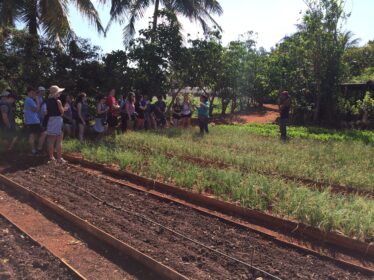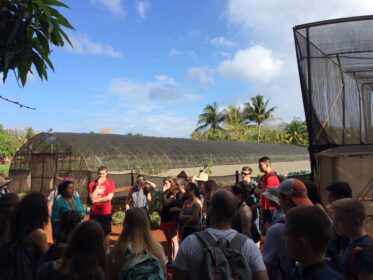Hola!
We had another great day in Cuba–looking toward the earth that nourishes the Cuban people and continues to fuel their social revolution, and also out to the sea that continues to inspire and soothe. We checked out of our hotel and headed toward Trinidad. Our first stop was Organoponico Alamar, east of Havana.This group was feeling pretty good about that wheelbarrow full of garlic.

We had a funny and comprehensive tour lead by the daughter of this amazing semi-urban organic farm on the forefront of the organic farming movement that started during the Special Period in Cuba. The Special Period began when the Soviet Union fell and, basically overnight, Cuba lost the sustained import of food and oil from the Soviet Union. The pre-Easter winds calmed the hot sun and provided for a wonderful climate to walk around the farm, learning about all the different aspects of production, including medicinal plants, vermicompost, and strange fruits and plants that some were daring enough to try.
By the end of the tour, we started to hear the call of the sea and made the short drive to the small fishing village of Cojimar, where Hemingway lived for some time. We had the bus drop us off along the seawall away from the main tourist area, and walked along the ocean feeling its strong salty breeze, occasionally standing by against the seawall, daring the waves to jump over and drench us. The waves didn’t hesitate to do so, which made for some funny moments. When we arrived at the castle and Hemingway statue, we enjoyed sitting in the sun, listening to a small trio play classic Cuban songs, as well as one the old Cuban man wrote about the friendship of Cuba and the US told using the example of Hemingway’s love for Cojimar.

A couple students took the lead to guide us to where we ate lunch, using their Spanish (which is improving dramatically) as we walked to ask Cubans for directions. After lunch we continue the bus journey, arriving in Trinidad before sunset.
Upon arrival in Trinidad we met with 11 different homestay or “casa particular” hosts. We split up into groups and settled into our casas, enjoying wonderful homecooked meals. Some students reported that they had conversations of more than 30 minutes with their hosts–entirely in Spanish! After dinner we met up as a group again and headed to La Casa de La Musica in Trinidad. Just after we got there and settled on the cobblestone steps overlooking the band, this over 10-piece salsa group started performing with the typical Cuban energy and unbelievable talent. A group of students didn’t hesitate to go down to the dance floor and get people moving. The salsa lesson in Havana was fun and useful, but here we were living it, breaking free from the 123, 567, and reacting to the dynamic music.

